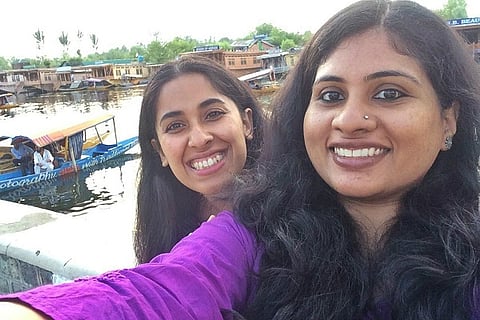

Three years ago, a chance opportunity to work on a film on weaving and handicraft in Varanasi led Keya Vaswani and Nidhi Kamath to discover their calling – they wanted to tell stories of crafts, handloom and the people behind them.
This marked the beginning of Storyloom Films, their production house which has made films telling the stories, culture and art of artisans and craftsmen in Jammu & Kashmir, Rajasthan, Madhya Pradesh, Odisha, Andhra Pradesh.
“Each design, each piece is made with a lot of love, care and emotion. It carries with it a culture because there is a community involved in making it. How do you put a price on that?” Keya asks.
It all started three years ago when Nidhi and Keya were students at the Indian Institute of Craft and Design (IICD) in Jaipur. A professor offered them a chance to make a film on weaving and handicraft in Varanasi for their diploma project. Driven by a desire to do something more than their course offered, they took it up even though filming wasn’t a part of their curriculum. With extensive research and a three-month long stay in the Varanasi, they completed their first film together, called ‘Threads of Benaras’.
It was then that they decided to tell the stories of weavers and artisans full-time and decided to set up a production house exclusively for that. Sitting on it for a month with “all sorts of weird names”, they finally decided on ‘Storyloom’. "It’s because we were weaving stories into the (hand)loom,” Keya smiles.

Nidhi and Keya at Keya's home in Bengaluru
Without a background in filmmaking, intitially they relied on help from the photography faculty in IICD and Keya’s brother, and on the Dewarists for inspiration. “But what eventually helped us is that we are both observant of our surroundings,” explains Keya.
Traveling into remote villages and unknown territories soon became a pleasure. “You have to remember that you are the outsider and make a conscious effort to mingle with the artisans.”
They quickly figured out a tactic to approach people: Mingle with the women and children of families they stayed with. “The men are usually wary because you’re a woman from the city and you have a camera. But once the women and kids like you, the men will grow to trust you too,” Keya explains.
“We do attract a lot of curiosity though.” Keya said the craftsmen would often ask them how they learnt to shoot, what they did for a living and so on. “Most of them will also ask us if we’re married,” she laughs, and jokes: “I’ve spent more time with Nidhi than I have with my husband. She and I are more like a harmonious married couple.”
Keya also talks about how traveling and working with craftsmen and artisans at close quarters shattered preconceived notions for them. Keya and Nidhi usually stay in the houses of the one of the artisans and Keya says that safety has never been a concern. “To tell you the truth, we have felt much safer and cared for there than in cities,” she admits.


Keya and Nidhi shooting in Machlipatnam, Andhra Pradesh
The duo’s first 30-minute venture, ‘Weaves of Maheshwar’, made under a People’s Archive of Rural India fellowship won them a national award. Spending eight months chronicling the weavers of the Maheshwari saris, they learned that the idea that handicrafts is a dying industry, is a myth.
Contrary to popular perception of artisans and weavers as a struggling lot, Maheshwar shone like a beacon of hope for them with its thriving weaving community. Keya says it is all because of Sally Holker, the woman who has revived Maheshwari sarees through her NGO, WomenWeave. "Whenever the weavers spoke about her, it was as if they were speaking about a god," recalls Keya.
She explains that Sally revived the industry with inputs from designers for new designs, and innovative marketing initiatives. A key part of her initiatives has been letting weavers set prices, based on their intimate knowledge of the labour involved.
What also caught Keya’s and Nidhi’s attention is the way Sally involved youngsters in the industry. She started a school where she taught them English, but mediated through the terms of weaving, thus piquing their interest in the craft. "She is the woman who holds it all together. She inspired us,” says Keya.
After extensive interaction with artisans, Keya realizes why textiles and handcrafts are more expensive than factory-made goods. “Once you see the amount of work, detail and effort that goes into each piece and the conditions they work in, you won’t bargain,” says Keya.